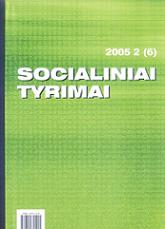Vartotojų ir į maistą orientuotų mažmenininkų sampratos palyginamoji analizė apie mažų kainų parduotuves
Comparative Analysis of Consumers’ and Foodstuff Retailers’ Conceptions about Low Price Type Stores
Author(s): Vytautas Dikčius, Raimonda Balnienė, Živilė VaitkūnienėSubject(s): Social Sciences
Published by: VšĮ Šiaulių universiteto leidykla
Keywords: Retailer; discount store; customer.
Summary/Abstract: The main goal of this study has been to develop the conceptual comparative framework which lets to ana-lyze customers and food retailers understanding about discount stores. Based on a survey of 433 customers and 35 experts, the study groups responses by eleven different criteria’s: by price level and main factors of purchasing food items by identifying priorities. Experience collected over emergence and development of Lithuanian retail chains is rather modest, therefore it was useful to analyse current processes and compare them with those in western countries. No defined store type concept exists at present in Lithuania, and that is the main reason why retailers have created their own models. As it occurred from the survey, retailers have autonomously named their stores and shops and classified them into different types. Most stores in the West alongside their names also carry their status indications, i. e. “supermarket”, or “discount store”. Such signs help clients handle the situation and show what is to be anticipated in the shop: its range of merchandise, price level, servicing. An independent institution usually operates in the country (e. g. food marketing institute or another association representing interests of retailers) which clearly defines and describes the types of stores. Thus a retailer, by giving certain status to its shop, assumes obligation to its use and so clients are not mislead. Retailing market participants in Lithuania classify their stores by giving them special names and thus differentiating them according to stock of merchandise, store space, price level. Consumers learn about the price level in the stores basing on their own experience and information available through the mass media. This forms a certain image in clients’ consciousness. To the question “what does the sign „hyper“ mean together with the name of a store” almost every resident in Lithuania would an-swer that it means a large store. Yet people in Lithuania could seldom explain correctly what „a discount store“ is. Lithuanian retailers themselves by developing such chains as Saulute, Norfa, and Pigiau grybo announce to the society that they are just the type of discount store operating retailers, but that is sometimes far from the truth. The research paper is aimed to: 1.Identify and describe discount stores charac-teristics. 2.Evaluate and identify customers and food retailers understanding about discount stores characteristics. 3.Identify priorities in choices of customers and food retailers’. The methods of statistical mathematical analysis have been used in the research. The analysis of research data has been done using SPSS.
Journal: Socialiniai tyrimai
- Issue Year: 2005
- Issue No: 6
- Page Range: 123-132
- Page Count: 10
- Language: Lithuanian

